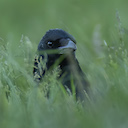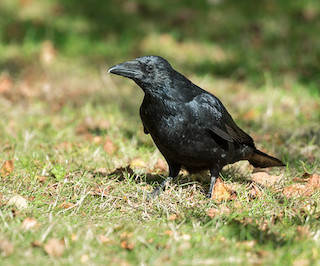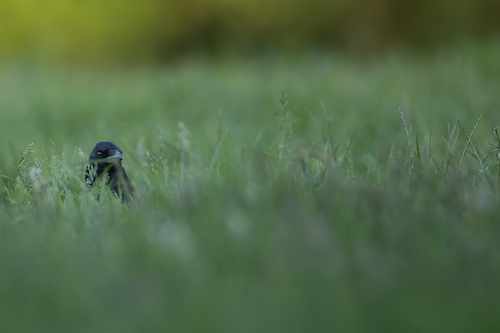
Carrion Crows can be seen throughout the year. All too often maligned in popular culture, these are amazing and intelligent birds.
Photo: © Richard Birchett
Scientific name: Corvus corone
Cornish name: Bran Dhu
UK conservation status: Birds of UK Conservation Concern, Green
What to look for:
• Colouring and appearance: All-black, purple-green sheened corvid, smaller than a Raven, and similar in size to a Rook. Black bill, feet and legs.
• Size: Length, 45 to 47 cm; Wingspan, 93 to 104 cm.
• Where: Mainly farmland and grassland, but ubiquitous across the UK (except north-west Scotland, Northern Ireland, and Isle of Man) in many different habitats, including urban as well as rural settings.
• Call: ‘Kraa’, among other varied vocalisations.
• Similar species: Rook, or compare with the larger Raven. Compared with the Rook, the Carrion Crow has a heavier bill and, unlike its corvid cousin, its thighs are not shaggy. It also does not sport the bare nostrils of the adult Rook, and its wings are broader and shorter (when observed in flight).

The Carrion Crow is an adaptable, plucky, intelligent and creative bird. Much maligned in myth and popular culture as a bringer of evil omens and bad luck, we are becoming increasingly aware of just how astounding they are. For example, they have been shown in studies to use tools to get food. Perhaps the most famous case hails from Japan, where Carrion Crows use cars to crack walnuts by placing them on pedestrian crossings or road junctions with traffic lights, so that the cars break them open as they drive over the nuts. The crows have learned to do this when the lights turn red, so they don’t get run over themselves.
To an inexperienced eye, Rooks can be mistaken for Carrion Crows, and vice versa. However, the latter do not have the shaggy thighs of the Rook, and the powerful black bill is heavier. Carrion Crows are also far less sociable, and are often seen singly, compared with the more gregarious Rook. An old saying holds that “a crow in a crowd is a rook and a rook on its own is a crow”.
They nest in isolation from others of their species, holding an extensive breeding territory (numbering over one million territories in the summer months). The large stick nest is usually built in a tree, but disused buildings and cliff ledges may also be used, and sometimes even the ground. A clutch of up to four eggs is incubated for almost three weeks by the female bird, with the male ensuring she stays well fed. Offspring from one year will sometimes stay with the parents and help raise their younger siblings the following year.
As their common name suggests, this is a scavenging species that eats carrion, but it will also feast on insects, worms, eggs, and fruit. They are noisy, too, croaking quickly in succession from a high vantage point, often accompanied by nods of its head.

Did you know…?
…Carrion Crows have been shown to recognise human faces, and even learn which humans are threatening and which not.
…The typical lifespan of a Carrion Crow in the wild is four years, but the maximum age from ringing is almost 21 years (from 2017 data).
…Carrion and Hooded Crows have only been recently recognised as separate species, rather than two sub-species. Hooded Crows are found in north-west Scotland and across Ireland.
More information and references:
Svensson, L., Mullarney, K., Zetterstrom, D.,1986. Collins Bird Guide, second edition (translated by Christie, D., Svensson, L.). HarperCollins, London.
Published: June 2020
Author: Amanda Scott
Photos: Upper: © Natural England/Julian Dowse; lower: Richard Birchett (website and Youtube channel)
